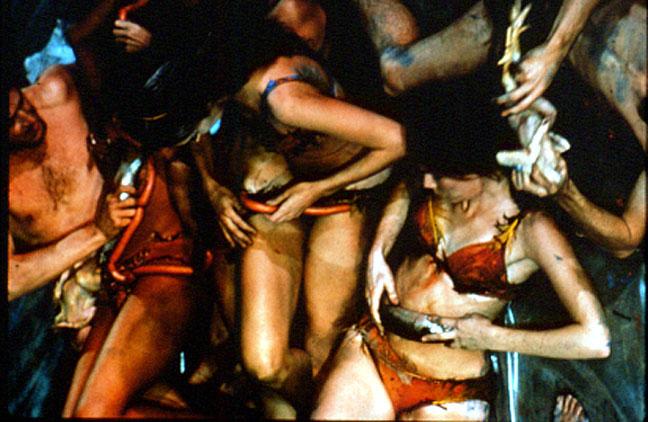
Carolee Schneeman’s controversial sixties-era films remain to my mind some of the most visually provocative reflections on the “deep and meaningless” facets of life during that turbulent period. Meat Joy (1964), made during an era of U. S. Cold War propaganda, Vietnam War escalation, and multiple political assassinations, celebrates flesh in a context that, at first, may seem anachronistic. And yet, American military and economic claims on the world provided artists of the period a safe space to reflect on the body and cultural taboos associated with libidinal experience.
Today, Meat Joy is a delight to view. The French voices and Dylan-esque harmonica background provide a feeling of joie de vivre that correlates with the playful embraces of scantily clad women and men. When processed fish, chicken, and sausage enter this orgy, I thought, okay, Schneeman is going to drive the metaphor down our throats (maybe not literally, but close enough). But visually, the performance remains so compact, visually kinetic and complex, and surprisingly light-hearted, that the gesture of, say, a fish, squeezed up tight between a young woman’s thighs, is, well, marvelous to behold in this context.
Schneeman’s argument, however, materializes the body—bringing it out of our minds, where too often it exists in submission to social and cultural ideals. By recontextualizing bodies on a stage in orgiastic abandon to the performative moment, the arms, legs, and torsos we see give definition to the space around them, and ask viewers to see bodies at play as they explore tabooed social boundaries.
Fuses (1967), by contrast, presents bodies in a much more intimate, domestic setting. With only ambient beach sounds to supplement the 22-minute, 16 mm film, the intimacy between Schneeman and her lover, James Tenney, is mediated through frequent narrative cuts, image-layers, and post-production manipulation of the celluloid itself. Despite the occasional glistening, post-coital cock, Fuses distances the audience from an experience of literal fucking. Instead, viewers witness an argument for how sexuality can be internalized and reflected on as an experience of the mind as well as of the body. If anything, the film is grounded in a mimesis that recalls the mental state during sex, with rapid image juxtapositions, visual submission to the body, ambient sources of light through a window, intrusions from a pet cat, and glimpses of the face of the other.
While the argument is made in a specifically hetero-context, the intrusion of ecstatic otherness often experienced in sexual intimacy is revealed here, making this a unique, and valuable, film about an area of life that typically remains hidden from popular view. Unlike pornography, which is about manipulating the image-as-product, aiming stylized sexual acts at a particular audience’s desire for physical gratification, Fuses, with its gorgeous shifts of light over the room and textured visual tableau, invites speculation from viewers on attitudes about sexuality, bodies, and expressive, if unconscious, forms.
I find films such as these compelling because they challenge our notions of suasion in the epideictic mode. Without explicit narratives—or even spoken arguments—we are left with the performative gestures of the visual frames of the films themselves.
Recent comments
2 years 29 weeks ago
2 years 44 weeks ago
2 years 44 weeks ago
2 years 50 weeks ago
3 years 4 weeks ago
3 years 4 weeks ago
3 years 4 weeks ago
3 years 6 weeks ago
3 years 6 weeks ago
3 years 6 weeks ago